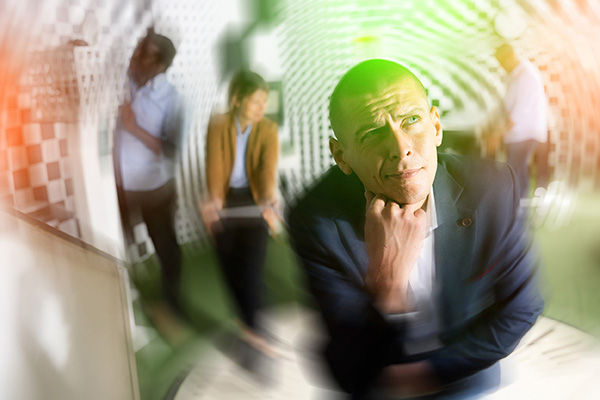How to Synchronize Your Thoughts with the Life You Wish To Achieve
 We draw into our lives what we anticipate. When parents, friends, peers, and most significantly, your own self-talk assert that you are insufficient, unintelligent, or unattractive, and you opt to accept such notions, they become your reality.
We draw into our lives what we anticipate. When parents, friends, peers, and most significantly, your own self-talk assert that you are insufficient, unintelligent, or unattractive, and you opt to accept such notions, they become your reality.
Reinforcing these thoughts within your subconscious solidifies this belief until it eventually manifests as truth in your existence. The subconscious accepts each statement it hears as fact, not differentiating between objective reality and what has simply been echoed frequently enough.
Self-talk, whether encouraging or filled with uncertainty, is internalized similarly. The subconscious operates like a curious child: eager to absorb all information, particularly messages that are consistent and repetitive. It hears and learns without judgment, merely assimilating and accepting.
This makes it challenging to distinguish between authentic inner truths and false beliefs established through repeated external influences, such as television content, narratives shared by others, or even our own internal dialogue.
Consider this: you might doze off while watching a cheerful, comedic show. Then, a disturbing war documentary airs. Although you’re no longer consciously engaged, your subconscious continues to process the content. Those distressing visuals and feelings may infiltrate your dreams, creating new fears and anxieties, even though they stem from fiction or someone else’s experience.
This serves as a strong reason to refrain from social media, television, or podcasts just before sleep. In those peaceful, accepting hours, your subconscious takes in everything — and what it absorbs can subtly influence your emotional and spiritual health without your awareness.
The greatest discovery of my generation is that human beings can alter their lives by altering their attitudes of mind ~ William James
The Impact Of Self-Talk
Self-talk stands as one of our most potent tools for personal growth. It carries the capacity to uplift or undermine us. When we converse with ourselves kindly, confidently, and with optimism, we sow the seeds for positive change.
Conversely, if we continually judge ourselves harshly, we erode our own foundation. As the adage suggests, if you often remind yourself that you can, you will. On the flip side, if you repeatedly insist that you cannot, you will almost certainly encounter failure.
It’s also crucial to realize that the subconscious mind captures everything, encompassing what you express to others. Comments made in jest or dishonesty can be retained as truths. Falsehoods can eventually solidify into beliefs and become part of your inner narrative. Over time, these beliefs may resurface to challenge you, as the subconscious regards them as facets of your reality.
Altering Your Thoughts
We frequently hear that altering your thoughts can transform your life. While this is a beautiful and empowering truth, executing it is often more challenging than it seems. You can immerse yourself in self-help audiobooks, read numerous motivational texts, and attend various spiritual seminars and workshops—yet still grapple with lingering feelings of insecurity or self-doubt.
This persistent “but” typically arises from internal resistance or a deeply embedded belief that genuine change is unattainable for you. Authentic transformation does not commence with external lessons; it begins with an internal shift—a profound and steadfast belief in your capacity to evolve, your worthiness of joy, abundance, and tranquility.
Most people are thinking about what they don’t want, and they’re wondering why it shows up over and over again ~ John Assaraf
The Resonance Of Doubt
Many individuals seek guidance in books such as The Secret by Rhonda Byrne (2006), Wayne Dyer’s Wishes Fulfilled (2012), and Gabrielle Bernstein’s Super Attractor (2019). These widely-read works all advocate for the fundamental idea that like attracts like. Your thoughts, feelings, and beliefs transmit a vibrational frequency that draws akin experiences into your existence. When you think positively and emotionally resonate with your desires, you begin to attract those outcomes toward you.
However, what often goes unacknowledged is the focus these authors emphasize on the essential foundation of belief, trust, and inner faith. Byrne discusses the importance of genuinely believing you already have what you desire. Dyer asserts that you must embrace the feeling of your wish already being realized. Bernstein encourages us to fully trust the universe and to feel deserving of receiving.
This, for many, presents the real challenge. Clients often express to me that they’re implementing everything advised by the books—visualizing, affirming, and expressing gratitude—but still feel entrenched. “What am I doing incorrectly?” they ponder. “Why isn’t the universe responding? Doesn’t the universe wish for my happiness?”
During readings, the spirit consistently conveys the same answer: “The universe is on your side.” Followed by a gentle nudge for self-reflection: “Ask yourself instead: Do you harbor even the slightest doubt that your request will be fulfilled?”
And often the reply is a soft, sincere, “Well… yes, just a little.”
A hint of doubt can obstruct the flow of manifestation. When you make a demand of the universe while doubting its feasibility, it’s as if you’re softly saying, “I hope this materializes, but I don’t genuinely believe it will… not for someone like me.”
We attract exactly what we anticipate. Doubt establishes the frequency you emit, and the universe, true to its essence as a reflector, responds accordingly. This captures the heart of energetic alignment. We manifest not what we desire, but what we genuinely expect. What we hope for does not materialize, but who we are does.
We must embody success before it will come to us. We must mentally, in terms of attitude, become the individuals we aspire to be ~ Earl Nightingale
Embracing The Co-Creative Journey
Manifestation represents a co-creative endeavor. You need to fulfill your role, engage actively in the process, and undertake aligned actions. The journey is seldom straightforward. There are curves, bumps, inclines, and dips. Sometimes, it’s essential to carve your own route through uncharted territory to discover places you’ve never ventured before. However, with persistence and firm belief, you will reach your desired destination. Why? Because you anticipate it.
When initiating a journey, you begin with the conclusion in mind. You understand your destination. You chart your course, gather resources, and have faith that you will arrive. You harbor no doubt about your destination; you progress with intention! That confidence and absence of hesitation is what facilitates the journey to unfold.
If you expect less, you will obtain less. When you envision the best for yourself, you pave the way for miracles. Yet remember that gifts do not always arrive in the forms you anticipate. They may manifest as challenges, surprises, or detours. Nevertheless, these too are gifts, frequently leading you to unforeseen blessings and deeper insights.
Foster the internal belief that you are worthy, your aspirations are legitimate, and the universe fully supports you. Treat yourself with compassion and truthfulness. Transform your subconscious into an ally along your journey instead of a reservoir of past limitations.
Anticipate miracles. Anticipate joy. Anticipate the life you genuinely desire, and it shall be yours.
|
Elizabeth’s abilities trace back through several generations. She recognized her own talents early on, discerning the distinctions between herself and most individuals surrounding her. Since then, she has refined and mastered various metaphysical practices, offering hypnotherapy, Psychic Mediumship, Mysticism, and Hypno-Reiki to her clients in Maine, as well as regions across the US and Canada, where she travels. A passionate animal lover, they serve as her greatest mentors, and these unconditionally loving beings often contribute to a reading alongside the Angels, Guides, and loved ones who provide resolutions and insights for each of her clients. Elizabeth is also an author steeped in spiritual wisdom and is currently penning a book. If you wish to experience her unique Psychic Wisdom, seek peace, and receive insights that will also benefit your highest good, you can connect with Elizabeth at Psychic Access. |
Aligning your thoughts with the life you wish to lead is an essential step in realizing your aspirations and living a satisfying life. By directing your thoughts and beliefs toward your objectives, you can bring forth your desires and craft the life you genuinely seek. Here are several strategies to help align your thoughts with the life you envision:
1. Define clear objectives: The initial step in aligning your thoughts with your desired life is to articulate distinct and specific goals. Take some time to contemplate what you truly want in life and document your goals. Ensure your goals are specific, measurable, attainable, relevant, and time-constrained (SMART). This will provide you with clear guidance and focus for your thoughts and actions.
2. Envision your success: Visualization is an effective tool that can assist you in aligning your mindset with the life you want. Dedicate some time each day to imagine yourself accomplishing your objectives and experiencing the life you aspire to lead. Picture yourself in vivid detail, relishing the success and fulfillment you yearn for. This practice will foster a positive mindset and attract the opportunities and resources necessary for reaching your goals.
3. Utilize positive affirmations: Affirmations are uplifting statements that can aid in reprogramming your subconscious and aligning your thoughts with your desires. Compile a list of affirmations reflecting your goals and recite them daily. For instance, if your aim is to establish a thriving business, you might say affirmations such as “I am a successful entrepreneur” or “I attract abundance and prosperity into my life.” This approach will help you remain focused and motivated on your objectives.
4. Surround yourself with positivity: Your surroundings significantly influence your thoughts and beliefs. Surround yourself with positive and encouraging individuals who believe in your aspirations and goals. Steer clear of negative influences and toxic relationships that can deplete your energy and impede your progress. Cultivate a positive and motivating environment that will help you remain focused and aligned with the life you wish for.
5. Practice thankfulness: Gratitude is a potent practice that can assist in aligning your thoughts with the life you desire. Dedicate some time each day to contemplate the things you are grateful for in your life. This will help you shift your attention from deficiency and scarcity to abundance and prosperity. Practicing gratitude will also draw in more positive experiences and opportunities.
6. Take inspired steps: Aligning your thoughts with the life you crave encompasses more than merely thinking positively; it also entails taking inspired steps toward your goals. Break down your objectives into smaller, achievable steps and consistently act toward realizing them. Trust your instincts and take bold and courageous steps toward your aspirations. This will enable you to synchronize your thoughts, beliefs, and actions with the life you desire.
In summary, aligning your thoughts with the life you aspire to is a transformative practice that can aid in accomplishing your goals and living a meaningful life. By defining clear objectives, envisioning your achievements, employing positive affirmations, surrounding yourself with positivity, practicing gratitude, and taking inspired actions, you can synchronize your thoughts, beliefs, and actions with your ambitions. Stay focused, remain positive, and believe in yourself – the life you long for is attainable. Continue reading
















